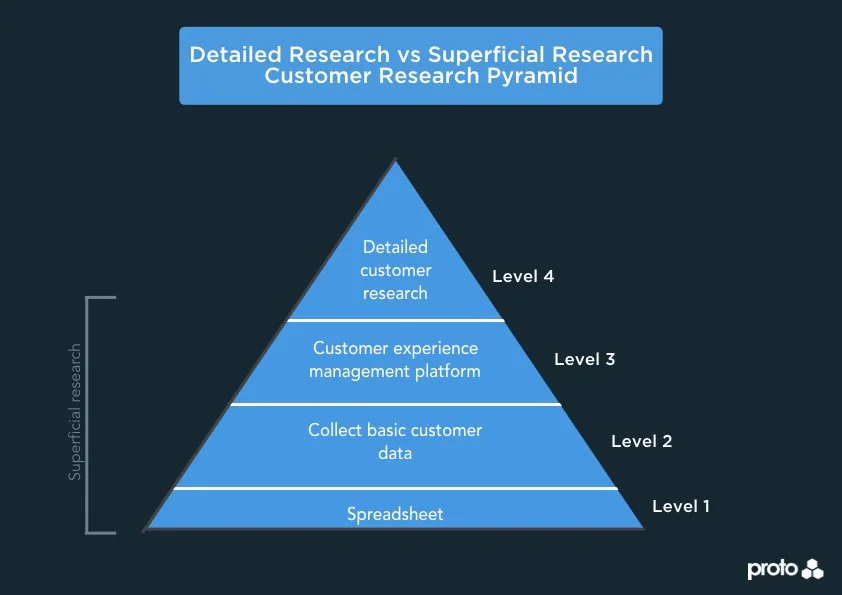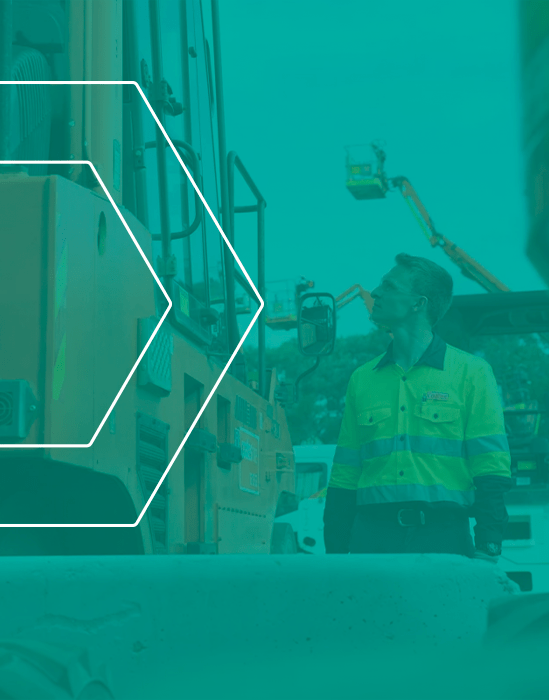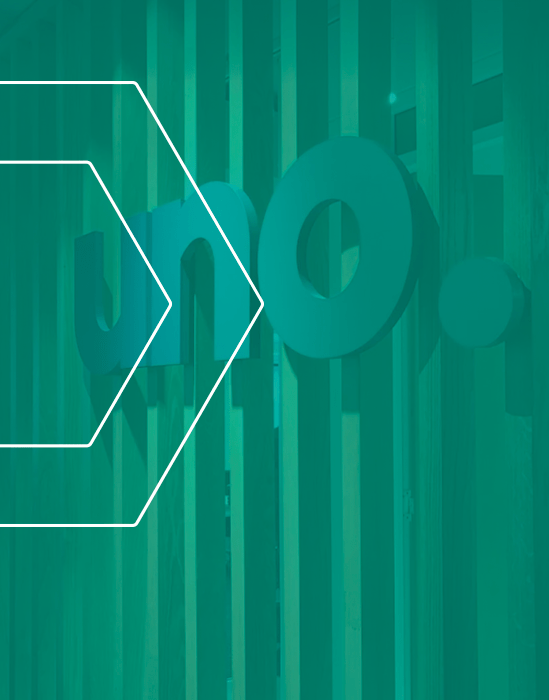
A Customer Research Agency That Turns Insight Into Growth
At Proto, we go beyond surveys and surface-level feedback. As a leading customer research agency in Australia, we help you uncover what your customers truly value, where your business is underperforming, and which investments will deliver the greatest return.
Our approach combines deep qualitative research with hard data to give you clarity, confidence, and measurable results. With over 15 years’ experience across industries, we’ve helped organisations cut waste, improve customer journeys, and grow with evidence-backed decisions.
We can help you assess your customer experience to uncover gaps, prove ROI, and give you a clear plan for improvement that drives measurable impact.
What we uncover
We dig into your customer experience to find where friction exists and opportunities are being missed.
Evidence-based analysis of customer behaviour patterns and decision drivers
Insights that reveal the biggest gaps between customer expectations and delivery
A clear view of which research priorities will drive the most business value
What we create
We create actionable research frameworks that turn customer insight into a strategic, measurable system.
Customer research strategy that connects findings to business goals
Research methodologies and data collection approaches that capture authentic customer voices
Clear roadmaps linking customer insights to revenue opportunities and operational improvements
What it delivers
We help you turn customer understanding into action, track results, and keep improving.
Step-by-step implementation support to embed customer insights across decision-making
ROI measurement frameworks that prove the value of customer research investments
Ongoing research capabilities to sustain customer understanding and competitive advantage
Ready to uncover customer insights that drive measurable growth?
Book a session with our team to discover what your customers really value, prioritize research opportunities, and get a clear plan to turn insights into ROI.
Areas of expertise
Human Centred Research
Drive innovation with human-centred research that places real customer needs at the heart of design. By combining qualitative insights with proven customer experience design methods, we ensure every product and service resonates deeply with your audience, building loyalty and long-term value.
Service Design & Innovation
Reimagine value delivery through service design and innovation. From redesigning key processes to introducing breakthrough experiences, we combine creativity with evidence-based frameworks, ensuring your experience design is efficient, impactful, and memorable at every touchpoint.
Customer Journey Mapping
Uncover opportunities with customer journey mapping that highlights pivotal touchpoints and pain points. Our CX design approach transforms these insights into actionable strategies, helping you craft seamless journeys that enhance satisfaction, reduce friction, and accelerate business growth.
Future State Experience Design
Stay ahead of customer expectations with future state experience design. By anticipating emerging behaviours and market shifts, we help you craft future-ready CX solutions that exceed standards, set benchmarks in your industry, and ensure your customer experience design remains competitive.
Customer Insights
Harness actionable customer insights to shape your design decisions with clarity and precision. We connect data, behaviour, and feedback into a clear narrative, ensuring every cx design initiative aligns with your customers’ evolving needs and expectations.

Customer Research Agency: Turn Customer Insights Into Measurable Growth
Most organisations collect customer data, but few transform it into a strategic advantage. A specialised customer research agency goes beyond surveys and surface-level feedback to uncover what customers truly value, where businesses underperform, and which investments deliver measurable returns. The difference between data collection and actionable insight often determines market success.
What is a Customer Research Agency?
A customer research agency is a specialised consultancy that applies rigorous research methodologies to understand customer behaviour, needs, and decision-making processes. Unlike internal research teams or generalist consultancies, dedicated customer research agencies combine deep methodological expertise with an objective external perspective to reveal insights that drive business growth.
Effective customer research agencies translate complex behavioural data into clear strategic frameworks that guide product development, service design, marketing strategy, and operational improvements. They bridge the gap between what customers say, what they do, and what drives business outcomes.
The Strategic Value of Professional Customer Research
Beyond Internal Assumptions
Internal teams often develop blind spots about customer needs based on organisational perspectives, product knowledge, and operational constraints. Customer research agencies provide objective external viewpoints that challenge assumptions and reveal opportunities invisible to internal stakeholders.
Professional researchers apply proven methodologies that eliminate bias, ensure statistical validity, and capture authentic customer voices rather than responses influenced by organisational relationships or social desirability pressures.
Evidence-Based Decision Making
Customer research agencies transform gut instincts and anecdotal evidence into data-driven strategies. This evidence base enables confident investment decisions, reduces implementation risk, and provides measurable frameworks for tracking success.
Research-backed strategies demonstrate clear ROI, justify resource allocation, and align organisational stakeholders around customer-centred objectives rather than internal preferences.
Competitive Intelligence and Market Understanding
Professional research reveals not just customer needs but competitive positioning, market gaps, and emerging trends that inform strategic planning. Agencies provide market context that helps organisations understand their position relative to alternatives and identify differentiation opportunities.
Core Customer Research Methodologies
Qualitative Research Excellence
Deep qualitative research uncovers the emotional drivers, unspoken needs, and behavioural patterns that quantitative data alone cannot reveal. Expert researchers conduct ethnographic studies, in-depth interviews, focus groups, and observational research that captures rich customer context.
Qualitative insights provide the "why" behind customer behaviourr, revealing motivation patterns that inform product development, messagingstrategiesy, and experience design decisions.
Quantitative Data Analysis
Rigorous quantitative research validates qualitative insights at scale while identifying statistically significant patterns across customer segments. Professional agencies design surveys, analyse transaction data, and apply advanced statistical techniques to ensure that findings are representative and actionable.
Quantitative analysis provides the measurement framework needed to track improvement, demonstrate ROI, and make confident predictions about customer response to strategic initiatives.
Mixed-Method Integration
The most valuable customer research combines qualitative depth with quantitative scale through integrated methodologies that provide a comprehensive understanding. Professional agencies know when to apply each approach and how to synthesise findings into unified strategic recommendations.
Mixed-method research provides both the rich context needed for strategic thinking and the statistical confidence required for major business decisions.
Digital Behaviour Analytics
Modern customer research includes analysis of digital touchpoints, online behaviour patterns, and technology-mediated interactions that reveal customer preferences through observed actions rather than stated intentions.
Digital analytics provide real-time insights into customer behaviour, identifying optimisation opportunities that enhance user experience and drive business performance.
Proto Partners' Customer Research Approach
Evidence Gathering That Captures Authentic Voices
We combine multiple research methodologies to capture genuine customer perspectives across all interaction types. Our evidence gathering includes structured interviews, behavioural observation, digital listening, and transaction analysis that reveals both explicit feedback and implicit behavioural patterns.
Research design ensures statistical validity while maintaining flexibility to explore unexpected findings that often provide the most valuable strategic insights.
Insight Synthesis for Strategic Action
Raw research data becomes actionable through sophisticated analysis that identifies behavioural drivers, segments customer populations, and connects findings to business outcomes. We translate complex behavioural patterns into clear themes that guide strategic decision-making.
Synthesis includes validation across multiple data sources to ensure findings are robust and representative rather than artifacts of particular research methods or timing.
Framework Development for Implementation
Customer insights become valuable only when they guide practical action. We develop strategic frameworks, including customer personas, journey maps, need-state analysis, and prioritised roadmaps, that translate research into specific business initiatives.
Implementation frameworks include success metrics, resource requirements, and timeline considerations that enable organisations to act confidently on research findings.
ROI Measurement and Validation
Our research approach includes measurement frameworks that track the business impact of customer-informed initiatives. This enables organisations to demonstrate research value while continuously refining customer understanding based on market response.
Measurement encompasses both leading indicators of customer satisfaction and lagging indicators of business performance, connecting research investments to financial outcomes.
Customer Research Applications Across Industries
Financial Services
Banks and financial institutions use customer research to understand decision-making processes for complex products, identify service delivery pain points, and develop trust-building strategies that differentiate in competitive markets.
Research reveals regulatory compliance opportunities that enhance rather than burden customer experience while meeting institutional requirements.
Healthcare and Medical Services
Healthcare organisations apply customer research to improve patient experience across the care continuum, understand treatment adherence factors, and design service delivery that balances clinical requirements with patient satisfaction.
Research identifies communication strategies and service design approaches that improve health outcomes while enhancing patient and family experience.
Retail and Consumer Products
Retailers leverage customer research to understand purchase decision factors, optimise product assortment, and design shopping experiences that drive conversion and loyalty across online and offline channels.
Research reveals customer segment differences that enable targeted marketing, personalised experiences, and product development aligned with actual customer needs.
Technology and Software
Technology companies use customer research to understand user adoption barriers, identify feature priorities, and design onboarding experiences that accelerate time-to-value for software products.
Research provides product development guidance that balances technical capabilities with user needs while identifying market expansion opportunities.
Customer Research Agency: Turn Customer Insights Into Measurable Growth
Most organisations collect customer data, but few transform it into a strategic advantage. A specialised customer research agency goes beyond surveys and surface-level feedback to uncover what customers truly value, where businesses underperform, and which investments deliver measurable returns. The difference between data collection and actionable insight often determines market success.
What is a Customer Research Agency?
A customer research agency is a specialised consultancy that applies rigorous research methodologies to understand customer behaviour, needs, and decision-making processes. Unlike internal research teams or generalist consultancies, dedicated customer research agencies combine deep methodological expertise with an objective external perspective to reveal insights that drive business growth.
Effective customer research agencies translate complex behavioural data into clear strategic frameworks that guide product development, service design, marketing strategy, and operational improvements. They bridge the gap between what customers say, what they do, and what drives business outcomes.
The Strategic Value of Professional Customer Research
Beyond Internal Assumptions
Internal teams often develop blind spots about customer needs based on organisational perspectives, product knowledge, and operational constraints. Customer research agencies provide objective external viewpoints that challenge assumptions and reveal opportunities invisible to internal stakeholders.
Professional researchers apply proven methodologies that eliminate bias, ensure statistical validity, and capture authentic customer voices rather than responses influenced by organisational relationships or social desirability pressures.
Evidence-Based Decision Making
Customer research agencies transform gut instincts and anecdotal evidence into data-driven strategies. This evidence base enables confident investment decisions, reduces implementation risk, and provides measurable frameworks for tracking success.
Research-backed strategies demonstrate clear ROI, justify resource allocation, and align organisational stakeholders around customer-centred objectives rather than internal preferences.
Competitive Intelligence and Market Understanding
Professional research reveals not just customer needs but competitive positioning, market gaps, and emerging trends that inform strategic planning. Agencies provide market context that helps organisations understand their position relative to alternatives and identify differentiation opportunities.
Core Customer Research Methodologies
Qualitative Research Excellence
Deep qualitative research uncovers the emotional drivers, unspoken needs, and behavioural patterns that quantitative data alone cannot reveal. Expert researchers conduct ethnographic studies, in-depth interviews, focus groups, and observational research that captures rich customer context.
Qualitative insights provide the "why" behind customebehaviourrr, revealing motivation patterns that inform product developmentmessaging strategiessy, and experience design decisions.
Quantitative Data Analysis
Rigorous quantitative research validates qualitative insights at scale while identifying statistically significant patterns across customer segments. Professional agencies design surveys, analyse transaction data, and apply advanced statistical techniques to ensure that findings are representative and actionable.
Quantitative analysis provides the measurement framework needed to track improvement, demonstrate ROI, and make confident predictions about customer response to strategic initiatives.
Mixed-Method Integration
The most valuable customer research combines qualitative depth with quantitative scale through integrated methodologies that provide a comprehensive understanding. Professional agencies know when to apply each approach and how to synthesise findings into unified strategic recommendations.
Mixed-method research provides both the rich context needed for strategic thinking and the statistical confidence required for major business decisions.
Digital Behaviour Analytics
Modern customer research includes analysis of digital touchpoints, online behaviour patterns, and technology-mediated interactions that reveal customer preferences through observed actions rather than stated intentions.
Digital analytics provide real-time insights into customer behaviour, identifying optimisation opportunities that enhance user experience and drive business performance.
Proto Partners' Customer Research Approach
Evidence Gathering That Captures Authentic Voices
We combine multiple research methodologies to capture genuine customer perspectives across all interaction types. Our evidence gathering includes structured interviews, behavioural observation, digital listening, and transaction analysis that reveals both explicit feedback and implicit behavioural patterns.
Research design ensures statistical validity while maintaining flexibility to explore unexpected findings that often provide the most valuable strategic insights.
Insight Synthesis for Strategic Action
Raw research data becomes actionable through sophisticated analysis that identifies behavioural drivers, segments customer populations, and connects findings to business outcomes. We translate complex behavioural patterns into clear themes that guide strategic decision-making.
Synthesis includes validation across multiple data sources to ensure findings are robust and representative rather than artifacts of particular research methods or timing.
Framework Development for Implementation
Customer insights become valuable only when they guide practical action. We develop strategic frameworks, including customer personas, journey maps, need-state analysis, and prioritised roadmaps, that translate research into specific business initiatives.
Implementation frameworks include success metrics, resource requirements, and timeline considerations that enable organisations to act confidently on research findings.
ROI Measurement and Validation
Our research approach includes measurement frameworks that track the business impact of customer-informed initiatives. This enables organisations to demonstrate research value while continuously refining customer understanding based on market response.
Measurement encompasses both leading indicators of customer satisfaction and lagging indicators of business performance, connecting research investments to financial outcomes.
Customer Research Applications Across Industries
Financial Services
Banks and financial institutions use customer research to understand decision-making processes for complex products, identify service delivery pain points, and develop trust-building strategies that differentiate in competitive markets.
Research reveals regulatory compliance opportunities that enhance rather than burden customer experience while meeting institutional requirements.
Healthcare and Medical Services
Healthcare organisations apply customer research to improve patient experience across the care continuum, understand treatment adherence factors, and design service delivery that balances clinical requirements with patient satisfaction.
Research identifies communication strategies and service design approaches that improve health outcomes while enhancing patient and family experience.
Retail and Consumer Products
Retailers leverage customer research to understand purchase decision factors, optimise product assortment, and design shopping experiences that drive conversion and loyalty across online and offline channels.
Research reveals customer segment differences that enable targeted marketing, personalised experiences, and product development aligned with actual customer needs.
Technology and Software
Technology companies use customer research to understand user adoption barriers, identify feature priorities, and design onboarding experiences that accelerate time-to-value for software products.
Research provides product development guidance that balances technical capabilities with user needs while identifying market expansion opportunities.
Professional Services
Service firms apply customer research to understand client decision-making processes, identify service delivery improvements, and develop positioning strategies that differentiate expertise in competitive markets.
Measuring Customer Research Success
Strategic Decision Impact
Track how research findings influence major strategic decisions, including product development priorities, market expansion plans, and resource allocation choices. Successful research changes organisational behaviour rather than confirming existing assumptions.
Business Performance Improvements
Measure business outcomes, including customer acquisition efficiency, retention rate improvements, revenue per customer increases, and market share gains that result from research-informed strategies.
Implementation Adoption
Assess how effectively research insights get translated into operational changes, process improvements, and customer-facing initiatives across the organisation.
Research ROI Demonstration
Calculate return on research investment through improved decision-making outcomes, reduced implementation risk, and accelerated time-to-market for customer-centred initiatives.
Common Customer Research Challenges
Research Quality and Methodology Rigour
Poor research design, inadequate sample sizes, and methodological flaws can yield misleading findings that lead organisations down ineffective strategies. Professional agencies ensure statistical validity and methodological rigour.
Insight Translation and Implementation
Many organisations struggle to translate research findings into practical action plans. Effective agencies provide implementation frameworks and change management support that bridge insight and execution.
Organizational Resistance and Change Management
Research findings often challenge established organisational beliefs and processes, creating resistance from stakeholders invested in current approaches. Success requires careful change management and executive sponsorship.
Measurement and Continuous Learning
One-time research provides limited value compared to ongoing customer understanding that evolves with market changes. Effective agencies establish measurement systems that enable continuous learning from customers.
Advanced Customer Research Techniques
Behavioural Economics Integration
Modern customer research incorporates insights from behavioural economics that reveal how cognitive biases, decision-making shortcuts, and contextual factors influence customer choices beyond rational analysis.
Predictive Analytics and Modelling
Advanced agencies utilise predictive modellingg to forecast customerbehaviourur based on research patterns, enablinthegy developmenof proactive strategies t rather than reactivresponsesse to market changes.
Journey Analytics and Optimisation
Sophisticated research combines customer journey mapping with performance analytics to identify specific touchpoint improvements that maximise business impact.
Segmentation and Personalisation Strategy
Research enables sophisticated customer segmentation that supports personalised marketing, product development, and service delivery strategies tailored to distinct customer needs.
The Future of Customer Research
AI-Enhanced Research Capabilities
Artificial intelligence will augment human research expertise through automated pattern recognition, sentiment analysis, and behavioural prediction, revealing insights that are impossible to detect through traditional methods alone.
Real-Time Customer Intelligence
Technology platforms will enable continuous customer research through integrated feedback collection, behavioural monitoring, and predictive analytics, providing real-time customer intelligence.
Ecosystem Research Integration
Customer research will expand beyond individual organisations to encompass customer behaviour across partner ecosystems, third-party platforms, and collaborative service delivery models.
Ethical Research and Privacy Protection
Future customer research must balance insight generation with privacy protection, requiring sophisticated approaches that provide valuable intelligence while respecting customer data rights.
Transform Your Customer Understanding with Proto Partners
Proto Partners combines rigorous research methodology with strategic business thinking to deliver customer insights that drive measurable growth. Our approach ensures research investments translate into practical action rather than theoretical understanding.
Why Choose Proto Partners as Your Customer Research Agency?
Our team understands the unique challenges facing Australian organisations and provides research insights that are tailored to local market contexts and cultural considerations. We combine academic research rigour with practical business application that enables confident strategic action.
Ready to Uncover Customer Insights That Drive Growth?
Contact Proto Partners today to discover how professional customer research can transform your understanding of customer needs and guide strategic decisions that deliver measurable business results. Our consultation process identifies specific research opportunities that align with your business objectives.
Schedule Your Customer Research Consultation: Take the first step toward evidence-based customer strategy with Proto Partners' research expertise. We'll assess your current customer understanding and develop research approaches that provide actionable insights for business growth.
Stop guessing about customer needs—partner with Proto Partners to uncover insights that guide confident strategic decisions and drive measurable business growth.
Service firms apply customer research to understand client decision-making processes, identify service delivery improvements, and develop positioning strategies that differentiate expertise in competitive markets.
Measuring Customer Research Success
Strategic Decision Impact
Track how research findings influence major strategic decisions, including product development priorities, market expansion plans, and resource allocation choices. Successful research changes organisational behaviour rather than confirming existing assumptions.
Business Performance Improvements
Measure business outcomes, including customer acquisition efficiency, retention rate improvements, revenue per customer increases, and market share gains that result from research-informed strategies.
Implementation Adoption
Assess how effectively research insights get translated into operational changes, process improvements, and customer-facing initiatives across the organisation.
Research ROI Demonstration
Calculate return on research investment through improved decision-making outcomes, reduced implementation risk, and accelerated time-to-market for customer-centred initiatives.
Common Customer Research Challenges
Research Quality and Methodology Rigour
Poor research design, inadequate sample sizes, and methodological flaws can yield misleading findings that lead organisations down ineffective strategies. Professional agencies ensure statistical validity and methodological rigour.
Insight Translation and Implementation
Many organisations struggle to translate research findings into practical action plans. Effective agencies provide implementation frameworks and change management support that bridge insight and execution.
Organizational Resistance and Change Management
Research findings often challenge established organisational beliefs and processes, creating resistance from stakeholders invested in current approaches. Success requires careful change management and executive sponsorship.
Measurement and Continuous Learning
One-time research provides limited value compared to ongoing customer understanding that evolves with market changes. Effective agencies establish measurement systems that enable continuous learning from customers.
Advanced Customer Research Techniques
Behavioural Economics Integration
Modern customer research incorporates insights from behavioural economics that reveal how cognitive biases, decision-making shortcuts, and contextual factors influence customer choices beyond rational analysis.
Predictive Analytics and Modelling
Advanced agencies use predictive modelling to forecast customer behaviour based on research patterns, enabling proactive strategy development rather than reactive response to market changes.
Journey Analytics and Optimisation
Sophisticated research combines customer journey mapping with performance analytics to identify specific touchpoint improvements that maximise business impact.
Segmentation and Personalisation Strategy
Research enables sophisticated customer segmentation that supports personalised marketing, product development, and service delivery strategies tailored to distinct customer needs.
The Future of Customer Research
AI-Enhanced Research Capabilities
Artificial intelligence will augment human research expertise through automated pattern recognition, sentiment analysis, and behavioural prediction, revealing insights that are impossible to detect through traditional methods alone.
Real-Time Customer Intelligence
Technology platforms will enable continuous customer research through integrated feedback collection, behavioural monitoring, and predictive analytics, providing real-time customer intelligence.
Ecosystem Research Integration
Customer research will expand beyond individual organisations to understand customer behaviour across partner ecosystems, third-party platforms, and collaborative service delivery models.
Ethical Research and Privacy Protection
Future customer research must balance insight generation with privacy protection, requiring sophisticated approaches that provide valuable intelligence while respecting customer data rights.
Transform Your Customer Understanding with Proto Partners
Proto Partners combines rigorous research methodology with strategic business thinking to deliver customer insights that drive measurable growth. Our approach ensures research investments translate into practical action rather than theoretical understanding.
Why Choose Proto Partners as Your Customer Research Agency?
Our team understands the unique challenges facing Australian organisations and provides research insights that work within local market contexts and cultural considerations. We combine academic research rigour with practical business application that enables confident strategic action.
Ready to Uncover Customer Insights That Drive Growth?
Contact Proto Partners today to discover how professional customer research can transform your understanding of customer needs and guide strategic decisions that deliver measurable business results. Our consultation process identifies specific research opportunities that align with your business objectives.
Schedule Your Customer Research Consultation: Take the first step toward evidence-based customer strategy with Proto Partners' research expertise. We'll assess your current customer understanding and develop research approaches that provide actionable insights for business growth—guessing abouttgabout cuneedsneedsd—partner with Proto Partners to uncover insights that guide confident strategic decisions and drive measurable business growth.













